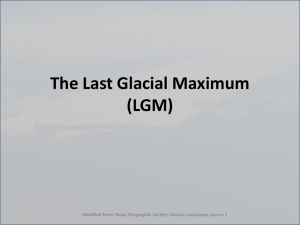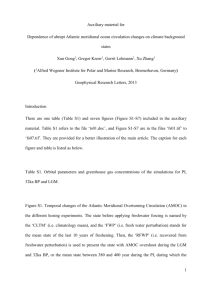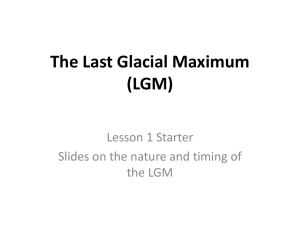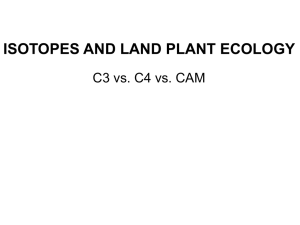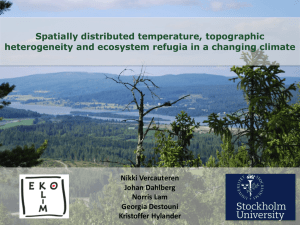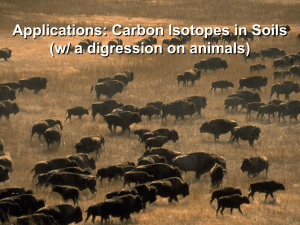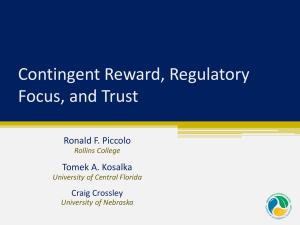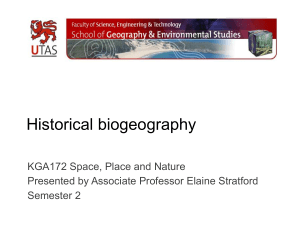Alpines, trees, and refugia
advertisement
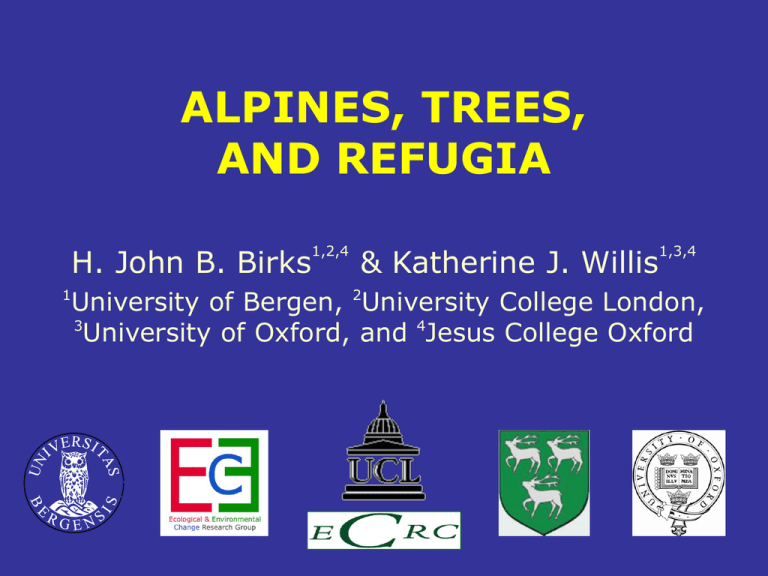
ALPINES, TREES, AND REFUGIA 1,2,4 H. John B. Birks 1 1,3,4 & Katherine J. Willis University of Bergen, 2University College London, 3 University of Oxford, and 4Jesus College Oxford Introduction Definitions Last Glacial Maximum Alpines in LGM Trees in LGM Southern and Mediterranean refugia Central, eastern, and northern refugia Current models based on available fossil evidence Is tree-growth in the LGM of central Europe possible? Holocene Cryptic refugia for alpines Conclusions INTRODUCTION The Quaternary period is the past 2.8 million years (Myr) of Earth’s history. A time of very marked climatic and environmental changes Large terrestrial ice-caps started to form in the Northern Hemisphere about 2.75 Myr, resulting in multiple glacialinterglacial cycles driven by variations in orbital insolation on Milankovitch time-scales of 400, 100, 41, and 19-23 thousand year (kyr) intervals Glacial conditions account for up to 80% of the Quaternary Remaining 20% consist of shorter interglacial periods during which conditions were similar to, or warmer than, present day Glacial conditions: 1. Large terrestrial ice-sheets 2. Widespread permafrost 3. Temperatures 10-25C lower than present at highmid latitudes 4. High aridity and temperatures 2-5C lower than present at low latitudes 5. Global atmospheric CO2 concentrations as low as 180 ppmv rising to pre-industrial levels of 280 ppmv in intervening interglacials 6. Steep climatic gradient across Europe and Asia during the Last Glacial Maximum (LGM) Major climate forcing for the last 450 kyr calculated at 60N. Global ice volume (f) plotted as sea-level, so low values reflect high ice volumes. Jackson & Overpeck 2000 Present day General circulation model (GCM) simulations of 21 kyr Last Glacial Maximum 21,000 cal. year BP Pollard & Thompson, 1997; Peltier, 1994 Ice-sheets Permafrost Relict soils Approximate extent of ice and of assumed continuous permafrost in Europe during LGM Willis 1996 Emphasis on Europe LGM Current interglacial – the Holocene ‘Alpines’ Trees Refugia Palaeobotanical evidence (macrofossils, microfossils) “…direct evidence can come only from fossils, indicating the existence, location, and duration of refugia, and their biotic composition in comparison with surrounding areas. Thus, palaeontology and genetics can operate synergistically, each suggesting fruitful geographical sampling areas for the other.” Stewart & Lister 2001 What do we know about the ranges of trees and alpines during the LGM? What do we know about ‘alpines’ during the current Holocene interglacial? DEFINITIONS ‘Alpines’ - plants that today have their main occurrences above the altitudinal tree-line or beyond the latitudinal tree-line. Includes alpines sensu stricto and arctic plants Last Glacial Maximum (LGM) – about 18000-25000 years ago, coldest period of the last (Weichselian) glacial stage Holocene – last 11500 years (~10000 radiocarbon years) of Earth’s history, so-called ‘post-glacial’ period or current interglacial Refugia – areas for the growth and survival of species during adverse or unfavourable environmental conditions. Sources for subsequent recolonisations when environmental conditions become more favourable - areas of survival for species during glacial episodes when temperate species survived in microenvironmentally favourable locations south of the continental ice-sheets and alpine species survived above or below the region of mountain glaciation and near the continental ice-sheets - refugia for other types of species also existed in areas far removed from glaciation (e.g. tropical rainforest refugia) Cryptic refugia – restricted refugia in northern Europe; areas of sheltered topography with buffered, stable local microclimates (Stewart & Lister 2001). Possibly not detectable by pollen analysis LAST GLACIAL MAXIMUM Vegetation 20 kyr ago Widespread ice, tundra, and steppe in north and east; parktundra in south and east, and forest confined to Mediterranean basin Iversen 1973 Older Dryas (ca. 14 kyr) landscape in Denmark Abundant alpines along with species of steppe habitats (e.g. Helianthemum, Hippophae, Ephedra) Iversen 1973 Possible LGM landscape in central Europe Open steppe with abundant Artemisia and Chenopodiaceae, and extensive loess deposition Alpines In LGM Besides familiar arctic-alpines found commonly as fossils such as Dryas octopetala Lychnis alpina Salix herbacea Saxifraga oppositifolia Salix reticulata Oxyria digyna Betula nana Bistorta vivipara Saxifraga cespitosa Silene acaulis also find fossils of plants not growing in central European mountains, only in northern Europe today Ranunculus hyperboreus Campanula uniflora Salix polaris Koenigia islandica Silene uralensis Pedicularis hirsuta Koenigia islandica Lang 1994 Other northern plants found as fossils in central Europe in LGM Salix polaris Silene uralensis Pedicularis hirsuta Ranunculus hyperboreus Common alpines in LGM throughout northern and central Europe Dryas octopetala Silene acaulis Bistorta vivipara Lychnis alpina Betula nana Saxifraga oppositifolia Trees in the LGM southern and Mediterranean refugia Interglacial LGM S N Traditional refugium model – narrow belt in southern mountains van der Hammen et al. 1971 Location of Ioannina basin in Pindus Mountains, NW Greece Tzedakis et al. 2002 LGM Tzedakis et al. 2002 Pollen evidence for traditional southern European LGM refugial model Pinus Quercus Fagus Ulmus Corylus Alnus Pistacia Tilia Betula Abies Bennett et al., 1991; Birks & Line, 1992 Taxa that have reliable macrofossil or pollen evidence for LGM presence in south European refugia Carpinus betulus Quercus pubescens Carpinus orientalis Quercus pyrenaica Castanea sativa Quercus robur Fraxinus ornus Quercus macrantha Olea europaea Quercus petraea Abies Phillyrea Acer Picea Alnus Pistacia Betula Pinus Corylus Tilia Fagus Ulmus Fraxinus What about trees in central, eastern, and northern Europe during the LGM? Detection difficult 1. Low pollen values – do these result from long-distance pollen transport or from small, scattered but nearby populations? Classic problem in pollen analysis since Hesselman’s question to Lennart von Post in 1916. No satisfactory answer. 2. Few continuous sites of LGM age 3. Pollen productivity related to temperature and some trees cease producing pollen under cold conditions 4. Pollen productivity may also be reduced by low atmospheric CO2 concentrations 5. Other sources of fossil evidence critically important – macrofossils, macroscopic charcoal, and conifer stomata Fossil evidence for trees and shrubs in LGM in northerly locations: pollen & macrofossil evidence • e.g. Palaeoecological results from Bulhary, South Moravia • Buried peat dated to 25,000 yr BP • Pollen record indicates existence of park-forest vegetation (Pinus sylvestris, Pinus cembra, Larix, Picea abies, Juniperus communis) • Excellent macrofossil E. Rybnícová & K. Rybníček, 1991. In: assemblage including Palaeoevegetational Developments in Betula pubescens and Salix Europe, Proceedings of the Pan-European Palaeobotanical Conference, 1991, Vienna sp. Museum of Natural History, pp 73-79. Fossil evidence for LGM refugia in northerly locations: pollen evidence from six sites in Romania Pinus Picea Betula Salix Juniperus Feurdean et al. 2007 Greatest diversity during the LGM found in midaltitude sites – 8001300m asl – in Romania Feurdean et al. 2007 Fossil evidence for trees in central and eastern Europe during the LGM: macroscopic charcoal evidence Willis & van Andel 2004 Scanning electron microscope images of wood charcoal Pol CzR Svk Aus Slo Hun Cro B&H Ukr Rom Ser CzR – Czech Republic; Aus – Austria; Slo – Slovenia; Cro – Croatia; Pol – Poland; Svk – Slovakia; Hun – Hungary; Ukr – Ukraine; Rom – Romania; Ser – Serbia; B&H – Bosnia & Herzegovina Willis & van Andel 2004 Willis & van Andel 2004 Tree taxa that have reliable macrofossil evidence for LGM presence in central, eastern, or northern European refugia Abies alba Pinus cembra Alnus glutinosa Pinus mugo Betula pendula Pinus sylvestris Betula pubescens Populus tremula Corylus Quercus Carpinus betulus Rhamnus cathartica Fagus sylvatica Salix aucuparia Fraxinus excelsior Sorbus Juniperus communis Taxus baccata Picea abies Ulmus Iberian, Italian, and Balkan peninsula LGM refugia – ‘classical’ model Not complete Southern + central + northern European LGM refugia Current model Bhagwat & Willis 2007 Current model based on available fossil evidence Ice sheet Northerly LGM refugia Mediterranean LGM refugia Willis et al. 2007 (in press) What was the LGM landscape like? In the lowlands north of the Alps, a mosaic of: 1. open-ground habitats on well-drained soils and exposed sites supporting a mixture of alpines, steppe, and ‘weed’ taxa 2. willow scrub on damper soils 3. tree populations on sheltered localities along river banks, in valleys, and in depressions where there was moisture and some shelter In the mountains south of the Alps, a mosaic of: 1. low-altitude steppe or shrub steppe 2. belt of trees at mid-altitudes where there was adequate moisture and temperatures were not too cold 3. high-altitude open habitats with alpines and cold-tolerant steppe plants North of the Alps Sichuan, China South of the Alps Borah Peak, Idaho Are there any ecological attributes characteristic of trees in southern LGM and northern LGM refugia? Bhagwat & Willis (2007) 23 trees - southern refugia: large, animaldispersed seeds - northern refugia: wind-dispersed seeds Could the trees identified in the macroscopic charcoal record have grown in the LGM environment of central, eastern, and northern Europe? Work in progress by Miguel Araújo, Shonil Bhagwat, and ourselves Basic approach is to model present-day tree distributions in relation to contemporary climate using seven different speciesclimate modelling algorithms (climate-envelopes, bagging trees, random forests, etc.) to develop an ‘ensemble forecasting framework’ for analysing species-climate relationships (Araújo & New 2006) Given modern tree-climate responses and LGM GCM model simulations from Paul Valdes, predict the LGM ranges for trees under LGM climates LGM GCM models – UGAMP (UK), ECHAM3 (Germany) predicted today predicted LGM & refugia S,N Corylus avellana S,N Fagus sylvatica predicted today predicted LGM & refugia S,N Alnus glutinosa S,N Betula pendula N Taxus baccata predicted today predicted LGM & refugia S,N Pinus sylvestris N Juniperus communis S,N Picea abies Combined probabilities of occurrence (potential quantity of suitable habitat) Today LGM Abies alba 0.22 0.22 = Alnus glutinosa 0.67 0.38 - Betula pendula 0.63 0.36 - Corylus avellana 0.62 0.31 - Fagus sylvatica 0.41 0.31 - Taxus baccata 0.26 0.23 - Juniperus communis 0.64 0.70 + Picea abies 0.38 0.45 + Picea omorika 0.09 0.26 + Pinus cembra 0.08 0.24 + Pinus mugo 0.13 0.20 + Pinus sylvestris 0.48 0.64 + Some trees may have had more potential habitat in LGM than today Early post-glacial migration rates in response to climate change based upon traditional refugial model Pinus Quercus Fagus Ulmus Corylus Alnus Pistacia Tilia Betula Abies Bennett et al. 1991 Tree-Spreading Rates • Currently assume spreading from southerly refugia only • These ‘rates’ of movement in early Holocene are then used in a number of climate envelope models to predict movement of plants in response to future climate change • But what if plants are not only in ‘southerly refugia’? • Similar study in USA found that some plants were much further north during the LGM than pollen evidence suggests (e.g. McLauchlan et al., 2005) • Spreading rates demonstrated to be vastly over-estimated • Significantly affects our predictions about how plants will respond to global warming Genetic-diversity Hotspots • Currently assumed that most plants (and animals) were located in southern refugia and therefore this is where genetic diversity will be greatest. • Holocene migration from these refugial regions can be mapped through genetic patterns. • Increasing evidence for certain groups of plants (and animals) that do not fit this ‘southerly refugial model’. • In order to map and protect centres of genetic diversity properly, need to have proper understanding of where the plants (and animals) existed during the LGM. • Major challenge to palaeoecologists. More data needed from unambiguous sources like macrofossils and macroscopic charcoal. Need to critically reassess LGM pollen data. Understanding ‘hotspots’ of genetic diversity very important to long-term conservation A. Hampe & R.J. Petit, 2005. Ecology Letters 8, 461-481; K.J. Willis & H.J.B. Birks, 2006. Science 314, 1261-1265 HOLOCENE Cryptic Refugia for Alpines Alpines widespread in LGM as shown by macrofossil evidence Became more restricted to alpine and arctic habitats above or beyond the tree-line in early Holocene with major climate warming and competition Some species also occur today in small, isolated ‘cryptic’ refugia within the potential forest zone Such cryptic refugia include sea-cliffs, other coastal habitats, inland cliffs and screes, open river-gravels, rocky gorges, and shallow soils on steep limestone slopes (Pigott & Walters 1954) Ramasaig Cliff, Skye Inchnadamph, W Sutherland High Force, Teesdale Cronkley Fell, Teesdale Yew Cogar Scar, Yorkshire Mullaghmore, County Clare Bettyhill, Sutherland Dryas octopetala, Sutherland Cetry Bank, Teesdale Falcon Clints, Teesdale Scar Close, Yorkshire Alpines in UK that descend to low-altitudes (<50m) or even to sea-level (*) include: Alchemilla alpina* Cerastium arcticum Oxyria digyna* Arctostaphylos uva-ursi* Draba incana* Polystichum lonchitis* Arctostaphylos alpina Dryas octopetala* Salix herbacea* Arenaria norvegica Empetrum nigrum ssp. hermaphroditum* Salix myrsinites Asplenium viride* Epilobium anagallidifolium Saxifraga aizoides* Betula nana Juniperus communis ssp. nana* Saxifraga hypnoides* Bistorta vivipara* Juncus trifidus Saxifraga oppositifolia* Cardaminopsis petraea* Juncus triglumis Sedum rosea* Carex bigelowii Loiseleuria procumbens Silene acaulis* Carex capillaris* Luzula spicata Thalictrum alpinum* Carex rupestris* Minuartia sedoides* Tofieldia pusilla Cerastium alpinum* Holocene thermal maximum in NW Europe between about 68 kyr with summers about 2-2.5C and winters 1-1.5C warmer than today. Presumably forest- and scrub-zones reached their highest levels at this time. Close correlation in Scandinavia between geographical distribution limits of alpines in lowland stations and maximum summer temperature, with the critical temperature varying over a range of at least 7C for different species (Dahl 1951). Lower limits for many alpines controlled directly or indirectly by summer warmth or its close correlates, including growth and competition from more vigorous, larger lowland species. As several alpines can be successfully grown in lowland gardens, their lower limits are more likely to be controlled by competition rather than by temperature directly (e.g. Sedum rosea). Holocene thermal maximum may have eliminated altogether some of the most warmth-sensitive or cold-demanding species of the LGM and late-glacial flora (e.g. Cassiope hypnoides, Papaver radicatum agg.) Others may have only survived in scattered localities at high levels (e.g. Diapensia lapponica, Sagina intermedia, Saxifraga cernua, Gnaphalium norvegicum). Competition-sensitive and warmth-sensitive. More warmth-tolerant species may have remained widespread and abundant over a greater altitudinal range (e.g. Dryas octopetala). Competition-sensitive only. Between these extremes, there are all degrees of ‘relictness’. Almost nothing is known from the fossil record about Holocene history of alpines. In process of becoming relict, actual localities in which a particular species survives may depend a good deal on chance. Extent of suitable habitat may also be important. A relict calcicole species will have a greater chance of survival in an extensive area of calcareous rocks than in an area with a very limited occurrence of suitable substrata. When conditions for growth of alpines become sub-optimal, plant disease, herbivory, and chance events (e.g. rock-falls) may be causes of decline or local extinction, giving relict distributions. CONCLUSIONS 1. Trees survived the Last Glacial Maximum in refugia in southern, central, and eastern Europe. 2. Alpines appear to have grown commonly in the LGM in northern and central Europe. 3. Existence of tree refugia in central and eastern Europe means that estimated rates of 500-1000 m per year for tree spreading are vast over-estimates as they assume refugia only around the Mediterranean Basin. 4. Many alpines grow in ‘cryptic refugia’ below the altitudinal tree-line or inside the latitudinal tree-line in naturally open habitats. 5. Cryptic refugia were occupied by trees in the LGM north of the Alps and by alpines in the Holocene. 6. Important implications of cryptic refugia to understanding genetic diversity. 7. Need for further LGM plant fossil evidence, especially macrofossils (seeds, fruits, leaves, macro-charcoal, stomata, etc.) as this is the only real proof of former presence. Provides ‘the factual basis for phytogeography’ (Godwin 1956, 1975). ACKNOWLEDGEMENTS Kathy Willis Oxford & Bergen Co-author ACKNOWLEDGEMENTS Shonil Bhagwat (Oxford) Miguel Araújo (Madrid) Hilary Birks (Bergen) Cathy Jenks (Bergen) DEDICATION Herbert E. Wright, Jr. on the occasion of his 90th birthday for stimulating our interest in LGM refugia in the USA, Iran, and south-eastern Europe. … but this evidence is based on very few pollen sequences Huntley & Allen, 2003 Region that has therefore typically been classified as having a full-glacial vegetation as ‘polar desert’ or ‘treeless’ steppe ? ? But why does it matter what vegetation existed in Eurasia during the last 21 kyr? But why does it matter what vegetation existed in Eurasia during the last 21 kyr? Key to understanding: • Response rates of plants (and some animals) to climate change • Genetic diversity of Eurasian plants animals • Accuracy of climate models (ME) Genetic Diversity Hotspots • Currently assumed that most plants and animals located in southern refugia and therefore this is where genetic diversity will be greatest • Postglacial migration from these refugial regions can be mapped through genetic patterns But increasing evidence of certain groups of plants and animas that do not fit this ‘southerly refugial model Alnus glutinosa [Black alder]1 Calluna vulgaris [Heather]4 Fraxinus excelsior [Ash]2 Pinus sylvestris [Scots pine]3 In order to properly map and protect centres of genetic diversity, need to have proper understanding of where the plants (and animals) existed during the last full-glacial Key Research Questions • What plants grew in Eurasia during last full-glacial to present? • Where were trees located on the landscape? • How quickly did plants migrate/move in response to early postglacial warming? • Where did they move to? Inferred extent of permafrost in Europe and N Eurasia during LGM (MAAT = mean annual air temperature) (Alfano et al. QR, 2003)
